
Edgar Allan Poe in Providence
Poe in Providence — The Laudanum, The Thwarted Engagement, and the Ether-Soaked Handerkerchiefs
Edgar Allan Poe's life was one calamity after another. He was orphaned and turned over to a couple that didn't seem to care very much for him. He attended the University of Virginia for a year, dropping out due to a lack of money. He enlisted in the U.S. Army under an assumed name and exaggerated age, and later attended the West Point military academy for seven months before contriving to get himself dismissed. When he was 26 he married his 13-year-old cousin and struggled to support her, her mother, and his invalid grandmother.
Poe inBaltimore Poe in
Philadelphia Poe in
New York City
Poe was the first well-known American writer to earn a living through writing alone, but it wasn't a prosperous living at all. American publishers largely printed unauthorized copies of works by British authors instead of paying for new works by American authors. Periodicals were booming, in general, but most folded after printing just a few issues. Their publishers often didn't pay their writers at all, or didn't pay them as much as they had promised, and generally delayed paying anything until the writers had been begging them for the payment for a significant time.
Poe managed to get work as a literary critic, an assistant editor, and an occasionally-paid author. The varied jobs had him moving between his hometown of Richmond, Virginia; Baltimore; and Philadelphia.
Eventually he moved on to New York City, where he worked briefly at the Evening Mirror and then became editor of the Broadway Journal. He eventually came to own that publication, but it failed in 1846. His young wife died in January 1847.
Both of Poe's parents, his child bride Virginia Clemm, and many of the writers and critics in the literary circles in which Poe moved died of tuberculosis. It was called "consumption" then, as the victim's vitality and body seemed to be consumed by the disease. More on this anon.
The literati largely of New York, but also up the coast to Boston and south at least as far as Baltimore, flirted and fought through poems, stories, and essays published in newspapers and literary journals, read at literary gatherings, sent through the mail, and delivered through other members acting as messengers. Many of These various writings were written or sent anonymously, or to and from pseudonyms.
Poe waded right into this. First, he accused Henry Wadsworth Longfellow of plagiarism. Then he was at both ends of romantic poetic writing and readings, sometimes addressed as "The Raven" in what was directed at him.
This led to episodes in which various individuals or groups demanded that Poe renounce or apologize for things he had not said or written, or that he return letters he had not solicited or even received.
That's right, Virginia didn't die until 1847.
Poe traveled to Providence in July 1845 with one of the literary ladies with whom he was in an apparently platonic but somewhat obsessive relationship. They passed a home where Poe saw Sarah Helen (Power–)Whitman out in the rose garden, but he didn't mention or ask anything about her at the time. But Poe had been instantly smitten at a distance. Here is Whitman's house at 88 Benefit Street with the Rhode Island state capitol building in the background. It has a dome of white Georgian marble, and is one of the top few largest self-supported marble domes in the world. Exactly where it ranks in the list of largest marble domes depends on precisely which dome-fanatic-modified list you consult. Good luck getting a reliable and consistent ranking out of that. But it's a big marble dome, probably in the top ten with no problem.
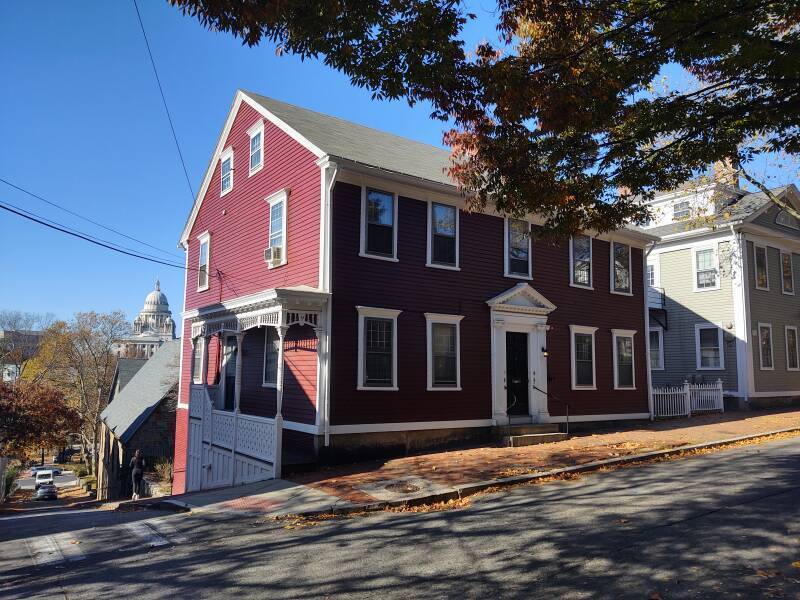
Back in New York, Poe made certain inquiries. He and Whitman were soon exchanging poems via public readings in tribute to pseudonyms, publication in various periodicals that had not yet failed, and through the mail.
Whitman was a young widow, no doubt due to consumption having taken Mr. Whitman. She draped herself in flowing gauzy garments with filmy scarves floating in the breeze. Around her neck she wore a momento mori, a "reminder of death", in her case a tiny coffin on a necklace. She was a mystic and a spiritualist, interested in mesmerism and the occult, and was said to conduct séances on most Sunday evenings. Stevie Nicks meets Morticia Adams. How could this not intrigue Poe?
Poe returned to Providence with a letter of introduction, and spent three successive evenings with Whitman, the third (of course) in the cemetery of Saint John's church, during which he begged her to marry him. The cemetery was just a short distance from Whitman's home, four houses north to 74 Benefit Street, around it, and then part-way down the hill.
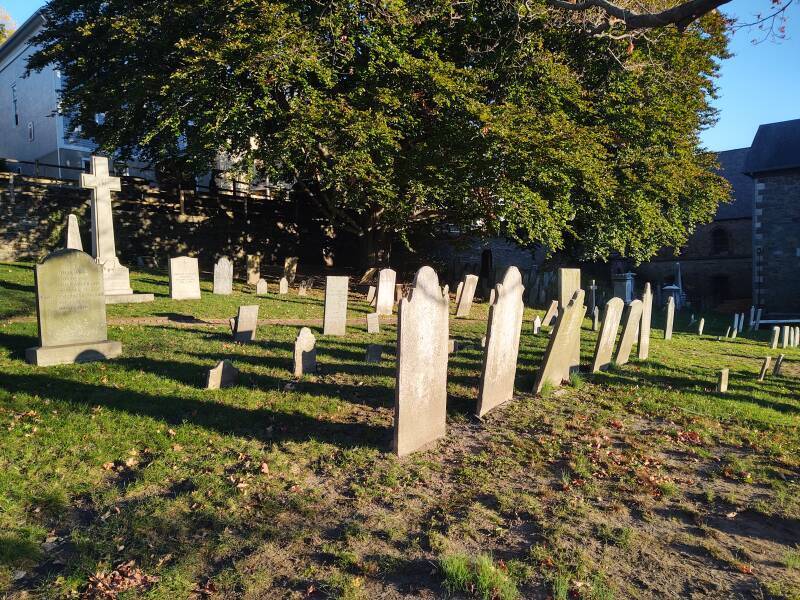
Lovecraft especially liked to visit this cemetery because of its connection to Poe.
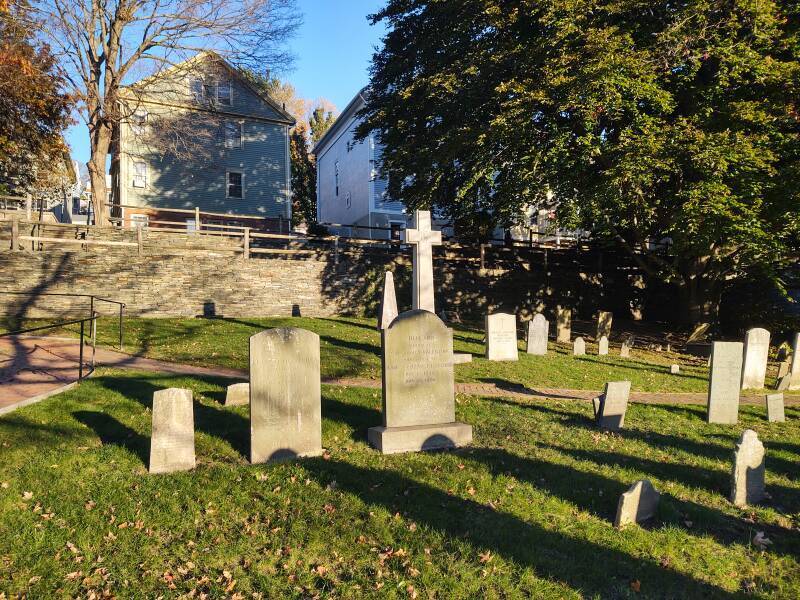
Lovecraft wrote about the cemetery in letters.
About the hidden churchyard of St. John’s—there must be some unsuspected vampiric horror burrowing down there & emitting vague miasmatic influences, since you are the third person to receive a definite creep of fear from it .... the others being Samuel Loveman & H. Warner Munn. I took Loveman there at midnight, & when we got separated among the tombs he couldn't be quite sure whether a faint luminosity bobbing above a distant nameless grave was my electric torch or a corpse-light of less describable origin! Munn was there with W. Paul Cook & me, & had an odd, unaccountable dislike of a certain unplaceable, deliberate scratching which recurred at intervals around 3 a.m. How superstitious some people are!
And:
Poe knew of this place, & is said to have wandered among its whispering willows during his visits here 90 years ago. Last August I shewed this place to two guests, & we all sat down on an altar-tomb & wrote rhymed acrostics on the name of Edgar Allan Poe...
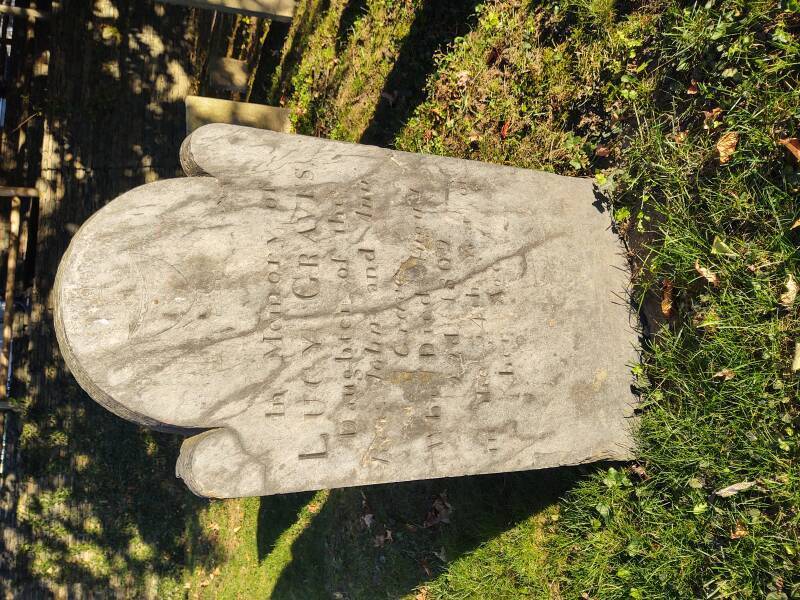
Lovecraft used archaic terms and spellings in his fiction and in his letters — inamorata, shewed, spurn'd, wander'd, thro', unchang'd finish'd, fane, balk'd, us'd, and so on.

Whitman was uncertain about Edgar, while her mother had no doubt and strongly opposed the relationship. Especially because of his heavy drinking, opium abuse, and ensuing erratic behavior. Plus, he gambled and had little money. And, he was said to be pursuing two other women, Annie Richmond and his childhood sweetheart Sarah Royster. But Poe was persistent.
On his way for one visit, Poe boarded the train in Lowell, Massachusetts, immediately after drinking two full doses of laudanum. That's opium dissolved in grain alcohol, readily available for purchase without a prescription until well into the 20th century.
Another version of the story reports it as four doses, and yet another describes it as two fluid ounces. I have no idea what a full adult dose of laudanum would be in either fluid ounces or milliliters, and I doubt that asking my doctor would be helpful.
The episode is sometimes described as a half-hearted suicide attempt. But I figure that since this was Poe, it was well within the bounds of his usual behavior. Maybe a slight over-estimation of how much laudanum was needed for this train trip. But he was on his way to visit his girlfriend, he wouldn't want to do himself in.
Poe and Whitman frequently visited the Providence Athenæum, a subscription library. It's at 251 Benefit Street, down the hill and one block east of the Brown University campus. It had been founded in 1836 by merging two earlier subscription libraries. It still operates today, under the same basic rules. Anyone can visit but only members can check out material. Or, in Poe's case, borrow someone else's credentials and check out material in their name.

During one visit she asked Poe if he had read the poem "Ulalume", and showed him the library's copy of the December 1847 issue of the American Whig Review, in which the poem had been published anonymously. Poe told her that he was the anonymous author, and signed his name in pencil at the bottom of the page. The Poe-signed periodical is still in the Athenæum's Special Collections.
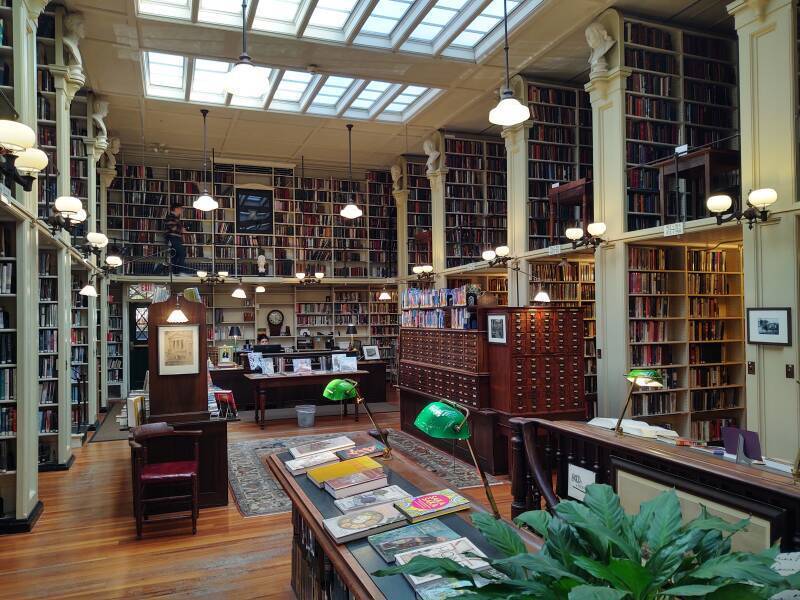
Post-Poe giants of American literature are well represented, including Dashiell Hammett and Raymond Chandler.

This is excellent.
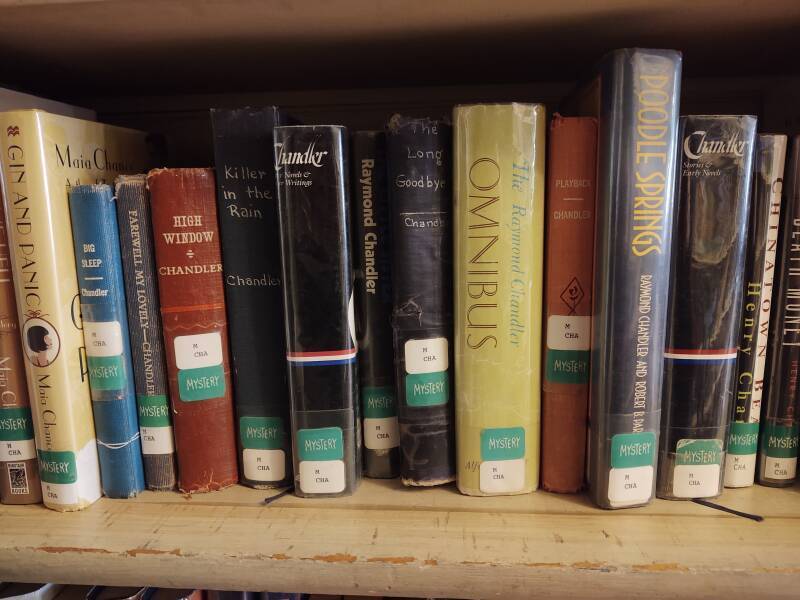
Henry Beckwith published the book Lovecraft's Providence & Adjacent Parts in 1979. A copy is in the Athenæum's Rhode Island connection. The self-guided tour mentioned it, and I found the book on the shelf. I took pictures of many of its pages to guide my explorations.
The Athenæum has an art collection in a room above the entrance, accessible to members only. Within the main room, a bust of Poe is above the entryway. A window above that lets you spot a daguerreotype of Poe, at left, and a painting of Whitman, right of center.

After enough visits to the Athenæum, Poe finally wore Whitman down and she agreed, or surrendered, to marry him. That is, if he would quit drinking.
Of course he promised to. And of course he didn't.
The wedding was set for December 24th, or possibly the 25th, of 1848. Accounts vary.
Whitman had been receiving anonymous letters warning her against having anything to do with Poe. That was part of the torrent of back and forth sniping and flirting and accusing and wooing in the literary community.
Then, just two days before the wedding, or on the day before in one account, Poe and Whitman were back at the Athenæum. When they briefly stepped apart, a stranger handed Whitman a note saying that not only had Poe been out drinking the night before, he had been drinking that morning.

Diethyl ether, (C2H5)2O, no longer recommended by most cardiologists.
Whitman told Poe that the wedding was off, and then ran out the door and eight blocks up Benefit Street to her home. There she prepared one of the ether-soaked handkerchiefs she used to treat a heart condition and draped it over her face. More 19th century medical science. Just keep your ether-soaked handkerchiefs well away from candles and other open flames. Poe had followed her but she managed to again tell him, just before losing consciousness in her self-anesthetized state, that the wedding was definitely off.
Based on how the collection was organized at that time, the Athenæum believes that this alcove is the very spot where they would have been, and thus where Sarah Helen Whitman dumped Edgar Allan Poe. The Athenæum has a very nice self-guided tour, this is one of the points on it.

The wedding had come so close to happening, and Poe and Whitman were prominent enough at least within literary and remote-poetry circles, that a newspaper in New London, Connecticut, announced the event and wished them well in January, 1849.
The essay "Friends and Enemies: Women in the Life of Edgar Allan Poe" presents one version of the Poe–Whitman story with one set of dates and laudanum doses, told with oft-times archaic vocabulary and orotund phrasing of which both Poe and Lovecraft would approve.
Poe didn't last much longer. Within a year, on October 3, 1849, he was found semiconscious along a street in Baltimore. He was "in great distress ... in need of immediate assistance", and wearing someone else's clothes. He was taken to a hospital where he died four days later, never having become coherent enough to explain how he came to be in that condition. All the medical records have been lost, and theories as to the cause of his death range through carbon monoxide poisoning, meningeal inflammation, rabies, and several other possibilities.
Edgar Allan Poe had one last indignity to suffer, this one post-mortem. Rufus Wilmot Griswold, an editor and critic who had maintained a grudge against Poe since 1842, wrote an obituary that was published in the New York Tribune and later reprinted throughout the country. Griswold also somehow became Poe's literary executor ("More like 'executioner'", as many said) and wrote articles and fake "memoirs" describing Poe as a drug-addled madman. These were accompanied by forgeries that Griswold claimed were letters written by Poe.
Eleven years after Poe's death, in 1860, Sarah Whitman published Was Poe Immoral? Edgar Allan Poe and his Critics, a work defending her former boyfriend and fiancé against the attacks. She lived on to the age of 75, somewhat unusual in that age of consumption.
Ill-Fated Tributes to Roger Williams
Between Poe's death in 1849 and Lovecraft's birth in 1890, the city of Providence tried twice to create a monument to Roger Williams. One episode turned out strangely, the other was an outright disaster.
In 1860, Providence residents wanted to raise a monument in Williams's honor. They dug where the grave was thought to have been back when the house collapsed over 160 years before. They found teeth and bone fragments, plus an apple tree root that they thought followed the shape of a human body. The Rhode Island Historical Society has diligently preserved this tree root ever since.
Slate Rock, a boulder on the west bank of the Seekonk River, was once one of Providence's most important historic landmarks. It was believed to be the spot where the Narragansetts greeted Williams with the famous phrase "What cheer, netop." In 1877 city workers accidentally blew it up. They were trying to expose a buried portion of the stone, but they used too much dynamite and the stone was "blasted to pieces" as described in 1912.
The New England Vampire Scare
Today this would, of course, be classified as a zombie panic.
Yes, there really was a New England vampire panic. It was mass hysteria in reaction to the high number of tuberculosis cases in the 19th century. Tuberculosis, called "consumption" at the time, was thought to be caused by the dead (or "undead") consuming the life force of their surviving relatives. Bodies were exhumed and their internal organs ritually burned to stop the suspected vampire from spreading the disease. This went on at least as long as the Mercy Lena Brown incident of 1892, which Lovecraft referenced in "The Shunned House" while also using the name Mercy for one of the characters:
It was Ann White who first gave definite shape to the sinister idle talk. Mercy should have known better than to hire anyone from the Nooseneck Hill country, for that remote bit of backwoods was then, as now, a seat of the most uncomfortable superstitions. As lately as 1892 an Exeter community exhumed a dead body and ceremoniously burnt its heart in order to prevent certain alleged visitations injurious to the public health and peace, and one may imagine the point of view of the same section in 1768.
— "The Shunned House", 1924, published in Weird Tales, October 1937.
Discussion question: Would Abraham Lincoln: Vampire Hunter have been improved with the inclusion of Poe as a character? The timeframe is correct, and apparently he does appear in the novel on which the film is based.
Now on to H. P. Lovecraft's life in Providence.
Yes, I realize that it's a cliché to refer to her as "a child bride" because even child brides eventually grow up. But she was just 13 when they married. "Ripening into a woman as she approached fourteen" is creepy.